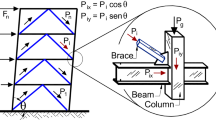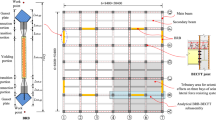Abstract
The adoption of a reliable shear model for predicting brittle failure modes of a reinforced concrete (r.c.) beam-column joint, beyond ductile flexural mechanisms at member level, is essential to retrofit r.c. framed buildings properly. The retrofitting of existing structures by means of the insertion of hysteretic damped braces (HYDBs) turns out to be a highly effective means of improving seismic response. In the present work, a Displacement-Based Design (DBD) procedure to proportion the HYDBs to attain, for a specific level of seismic intensity, a designated performance level has been revisited in order to take into account the effects of the nonlinear shear response of beam-column joints. To this end, two-, four- and eight-storey r.c. framed structures, representative of low-, mid- and high-rise r.c. framed buildings, are designed in line with a former Italian seismic code for a medium-risk seismic zone. These are then to be retrofitted by inserting HYDBs to attain performance levels imposed by the current Italian code in a high-risk seismic zone. A computer code for the nonlinear static analysis of r.c. framed structures has been developed, involving local shear response of beam-column joints. A path-following analysis based on the arc-length method has been adopted to obtain the pushover curves of primary and retrofitted test structures, with and without nonlinear shear modelling of the beam-column joints, and the HYDB response is idealized by a bilinear law on the assumption that buckling of the steel braces is prevented.
















Similar content being viewed by others
References
Alath S, Kunnath SK (1995) Modeling inelastic shear deformation in RC beam-column joints. In engineering mechanics proceedings of the 10th conference, University of Colorado at Boulder, Colorado, May 21–24, New York, ASCE, 2, pp 822–825
Altoontash A (2004) Simulation and damage models for performance assessment of reinforced concrete beam-column joints. Ph.D. Thesis. California, Department of Civil and Environmental Engineering, Stanford University
Celik OC, Ellingwood BR (2008) Modeling beam-column joints in fragility assessment of gravity load designed reinforced concrete frames. J Earthquake Eng 12(3):357–381
Christopoulos C, Filiatrault A (2006) Principles of passive supplemental damping and seismic isolation. IUSS Press, Istituto Universitario di Studi Superiori di Pavia, Italy
Clyde C, Pantelides CP, Reaveley LD (2000) Performance-based evaluation of exterior reinforced concrete buildings joints for seismic excitation. Pacific Earthquake Engineering Research Center, University of California, Berkeley, U.S.A., PEER Report, No. 2000/05
De Risi MT (2015) Seismic performance assessment of RC buildings accounting for structural and non-structural elements. Ph.D. Thesis, University of Naples Federico II, Naples, Italy
De Risi MT, Ricci P, Verderame GM (2017) Modelling exterior unreinforced beam-column joints in seismic analysis of non-ductile RC frames. Earthquake Eng Struct Dynam 46(6):899–923
DM96 1996. Norme tecniche per le costruzioni in zone sismiche e relative istruzioni. Italian Ministry of Public Works, D.M. 16-01-1996 and C.M. 10-04-1997
Fahnestock LA, Sause R, Ricles JM (2006) Analytical and large-scale experimental studies of earthquake-resistant buckling-restrained braced frame systems. Engineering research center for advanced technology for large structural systems, Lehigh University, Bethlehem, PA, Report ATLSS 06-01
Foti D, Diaferio M, Nobile R (2010) Optimal design of a new seismic passive protection device made in aluminium and steel. Int J Struct Eng Mech 35(1):119–122
Foti D, Diaferio M, Nobile R (2013) Dynamic behavior of new aluminum-steel energy dissipating devices. Struct Control Health Monit 20(7):1106–1119
Fujii K (2015) Application of the pushover-based procedure to predict the largest peak response of asymmetric buildings with buckling-restrained braces. In COMPDYN 2015, 5th ECCOMAS thematic conference on computational methods in structural dynamics and earthquake engineering, Crete, Greece, May 25–27, paper n. 836
Garcea G, Trunfio GA, Casciao R (1998) Mixed formulation and locking in path-following nonlinear analysis. Comput Methods Appl Mech Eng 165(1–4):247–272
Jeon J-S (2013) Aftershock vulnerability assessment of damaged reinforced concrete buildings in California. Ph.D. Thesis, School of Civil and Environmental Engineering, Georgia Institute of Technology, Georgia, USA
Jeon J-S, Lowes LN, DesRoches R, Brilakis I (2015) Fragility curves for non-ductile reinforced concrete frames that exhibit different component response mechanisms. Eng Struct 85:127–143
Kim J, Choi H (2006) Displacement-based design of supplemental dampers for seismic retrofit of a framed structure. J Struct Eng 132(6):873–883
Kim J, LaFave JM (2008) Probabilistic joint shear strength models for design of RC beam–column connections. ACI Struct J 105(6):769–779
Mazza F (2014) Modeling and nonlinear static analysis of reinforced concrete framed buildings irregular in plan. Eng Struct 80:98–108
Mazza F (2016a) Nonlinear seismic analysis of unsymmetric-plan structures retrofitted by hysteretic damped braces. Bull Earthq Eng 14:1311–1331
Mazza F (2016b) Nonlinear seismic analysis of r.c. framed buildings with setbacks retrofitted by damped braces. Eng Struct 126:559–570
Mazza F, Vulcano A (2015) Displacement-based design procedure of damped braces for the seismic retrofitting of r.c. framed buildings. Bull Earthq Eng 13(7):2121–2143
Mazza F, Mazza M, Vulcano A (2015) Displacement-based seismic design of hysteretic damped braces for retrofitting in-elevation irregular r.c. framed structures. Soil Dyn Earthq Eng 69:115–124
Mazza F, Pedace E, Del Favero F (2017) Effectiveness of damped braces to mitigate seismic torsional response of unsymmetric-plan buildings. Mech Syst Signal Process 85:610–624
NTC08 2008. Technical regulations for the constructions. Italian Ministry of the Infrastructures, D.M. 14-01-2008 and C.M. 02-02-2009
Pan Z, Guner S, Vecchio FJ (2017) Modeling of interior beam-column joints for nonlinear analysis of reinforced concrete frames. Eng Struct 142:182–191
Pantelides CP, Hansen J, Nadauld J, Reaveley LD (2002) Assessment of reinforced concrete building exterior joints with substandard details. Pacific Earthquake Engineering Research Center, University of California, Berkeley, U.S.A., PEER Report, No. 2002/18
Park S, Mosalam KM (2012) Analytical model for predicting the shear strength of unreinforced exterior beam-column joints. ACI Struct J 109:149–159
Ricci P, De Luca F, Verderame GM (2011) 6th April 2009 L’Aquila earthquake, Italy: reinforced concrete building performance. Bull Earthq Eng 9(1):285–305
Riks E (1979) An incremental approach to the solution of snapping and buckling problems. Int J Solids Struct 15:529–551
Riks E (1992) On formulation of path–following techniques for structural stability analysis. New Advances in Computational Structural Mechanics 65–79
Sharma A, Eligehausen R, Reddy GR (2011) A new model to simulate joint shear behavior of poorly detailed beam–column connections in RC structures under seismic loads, part I: exterior joints. Eng Struct 33:1034–1051
Shin M, LaFave JM (2004) Modeling of cyclic joint shear deformation contributions in RC beam-column connections to overall frame behavior. Struct Eng Mech 18(5):645–669
Sorace S, Terenzi G (2013) Structural assessment of a modern heritage building. Eng Struct 49:743–755
Sorace S, Terenzi G (2017) Existing prefab R/C industrial buildings: seismic assessment and supplemental damping-based retrofit. Soil Dyn Earthq Eng 94:193–203
Sorace S, Terenzi G, Mori C (2016) Passive energy dissipation-based retrofit strategies for R/C frame water towers. Eng Struct 106:385–398
Vecchio FJ, Collins MP (1986) The modified-compression field theory for reinforced concrete elements subjected to shear. J Am Concr Inst 83(2):219–231
Acknowledgements
The present work was financed by Re.L.U.I.S. (Italian network of university laboratories of earthquake engineering), in accordance with “Convenzione D.P.C.–Re.L.U.I.S. 2017, PR6 line, Isolation and Dissipation”.
Author information
Authors and Affiliations
Corresponding author
Rights and permissions
About this article
Cite this article
Mazza, F. Shear modelling of the beam-column joint in the nonlinear static analysis of r.c. framed structures retrofitted with damped braces. Bull Earthquake Eng 16, 2043–2066 (2018). https://doi.org/10.1007/s10518-017-0269-5
Received:
Accepted:
Published:
Issue Date:
DOI: https://doi.org/10.1007/s10518-017-0269-5




